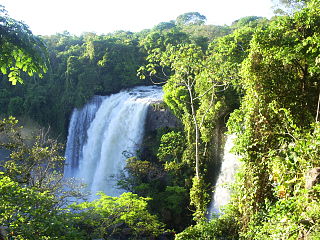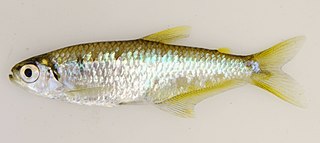| Rhinopetitia | |
|---|---|
| Scientific classification | |
| Domain: | Eukaryota |
| Kingdom: | Animalia |
| Phylum: | Chordata |
| Class: | Actinopterygii |
| Order: | Characiformes |
| Family: | Characidae |
| Genus: | Rhinopetitia Géry, 1964 |
| Type species | |
| Rhinopetitia myersi Géry, 1964 | |
| Rhinopetitia | |
|---|---|
| Scientific classification | |
| Domain: | Eukaryota |
| Kingdom: | Animalia |
| Phylum: | Chordata |
| Class: | Actinopterygii |
| Order: | Characiformes |
| Family: | Characidae |
| Genus: | Rhinopetitia Géry, 1964 |
| Type species | |
| Rhinopetitia myersi Géry, 1964 | |
There are currently 2 recognized species in this genus: [1]

Characidae, the characids or characins, is a family of freshwater subtropical and tropical fish belonging to the order Characiformes. The name "characins" is an historical one, but scientists today tend to prefer "characids" to reflect their status as a, by and large, monophyletic group. To arrive there, this family has undergone much systematic and taxonomic change. Among those fishes remaining in the Characidae currently are the tetras, comprising the very similar genera Hemigrammus and Hyphessobrycon, as well as a few related forms, such as the cave and neon tetras. Fish of this family are important as food in several regions, and also constitute a large percentage of captive freshwater aquarium fish species.

Hyphessobrycon is a genus of freshwater fish in the family Characidae. These species are among the fishes known as tetras. The genus is distributed in the Neotropical realm from southern Mexico to Río de la Plata in Argentina. Many of these species are native to South America; about six species are from Central America and a single species, H. compressus is from southern Mexico.

Astyanax is a genus of freshwater fish in the family Characidae of the order Characiformes. Some of these fish, like many of their relatives, are kept as aquarium pets and known collectively as tetras. With around 150 described species and new ones being described yearly, this genus is among the largest of the entire order; Hyphessobrycon also has more than 145 species and which one is larger at any one time depends on whether more species have been recently described in one or the other. The blind and colorless cave tetra of Mexico is a famous member of the genus, but its taxonomic position is disputed: Some recognize it as part of the Mexican tetra and this is supported by phylogenetic evidence, but others recognize the cave form as a separate species, A. jordani.

Leporinus is a genus of fish in the family Anostomidae native to South America. The fossil species Leporinus scalabrinii, known from the late Miocene of Entre Ríos in Argentina, has only recently been added to this genus after being misidentified as a species of primate under the name Arrhinolemur scalabrinii for over 100 years.

The Curuá River is a tributary of the Iriri River in Pará state in north-central Brazil. The river flows through the Tapajós-Xingu moist forests ecoregion. The river rises in the 342,192 hectares Nascentes da Serra do Cachimbo Biological Reserve, a strictly protected conservation unit established in 2005. It is one of the headwaters of the Xingu River.

Moenkhausia is a genus of freshwater fish in the family Characidae native to tropical and subtropical South America. These are medium-sized tetras where the largest species only reach around 12 cm (4.7 in).

Bryconamericus is a genus of characins found in Central and South America.

Creagrutus is a genus of characins found mostly in South America, with one species C. affinis extending into Panama in Central America.

Diapoma is a genus of characins from tropical South America.

Hemigrammus is a genus of freshwater fish in the family Characidae native to South America and commonly seen in the aquarium trade. These are medium-small tetras where the largest species reach up to around 11 cm (4.3 in).
Hysteronotus megalostomus is a species of characin endemic to Brazil where it is found in the upper São Francisco River basin. This species is the only member of the genus Hysteronotus.

Jupiaba is a genus of characins from South America. with 29 currently described species:
Knodus is a genus of characins, small freshwater fish from South America.
Phallobrycon is a genus of fish in the family Characidae endemic to Brazil.

Tetragonopterus is a genus of fish in the family Characidae native to South America.
Tyttobrycon is a genus of characins native to the Amazon Basin in South America.
Xenurobrycon is a genus of characins from tropical South America.

Characidium is a genus of fish in the family Crenuchidae. They are mainly found in South America, but C. marshi is from Panama. They are small, slender fish that live on the bottom in flowing fresh waters and feed on small animals such as insects.
Curimatopsis is a genus of small South American fish in the family Curimatidae. They are native to freshwater habitats in the Amazon, Orinoco and Paraguay basins, as well as river of the Guianas.

Erythrocharax altipinnis is a species of characid known only from Pará, Brazil, where it has been found in a small river. This species grows to 2.62 cm (1.03 in) in standard length. This species is the only known member of its genus.